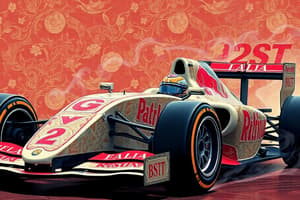Podcast
Questions and Answers
What is a common tyre strategy for the Silverstone Circuit?
What is a common tyre strategy for the Silverstone Circuit?
- No pit stops strategy
- 2-stop strategy with soft tyres for the first stint and medium or hard tyres for the second and third stints (correct)
- 1-stop strategy with soft tyres
- 3-stop strategy with hard tyres
What can be critical in terms of timing due to the high-speed nature of the Silverstone Circuit?
What can be critical in terms of timing due to the high-speed nature of the Silverstone Circuit?
- Fuel consumption
- Pit stops (correct)
- Pre-race practice
- Weather conditions
Where is the Silverstone Circuit located?
Where is the Silverstone Circuit located?
Northamptonshire, England, UK
The first Grand Prix at Silverstone Circuit was in 1950.
The first Grand Prix at Silverstone Circuit was in 1950.
The Silverstone Circuit has a total of __ corners.
The Silverstone Circuit has a total of __ corners.
What is the minimum weight for Formula 1 cars during a race?
What is the minimum weight for Formula 1 cars during a race?
Match the following F1 component with its description:
Match the following F1 component with its description:
Flashcards
Silverstone Tyre Strategy
Silverstone Tyre Strategy
High-speed tracks like Silverstone lead to high tire degradation, usually requiring 2-stop strategies utilizing soft-medium-hard tire combinations.
Silverstone Pit Stops
Silverstone Pit Stops
Due to high speeds and frequent tire degradation, strategic pit stops during safety car periods or when rivals pit are crucial for minimizing time loss.
Formula 1 Car Weight
Formula 1 Car Weight
The minimum weight of a Formula 1 car, including driver and fuel, is 733 kg.
Formula 1 Engine
Formula 1 Engine
Signup and view all the flashcards
Fuel Limit F1
Fuel Limit F1
Signup and view all the flashcards
Silverstone Circuit Length
Silverstone Circuit Length
Signup and view all the flashcards
Silverstone Circuit Laps
Silverstone Circuit Laps
Signup and view all the flashcards
Study Notes
Race Strategy
- Tyre Strategy: Silverstone, known for its fast straights and demanding corners, is classified as a high-speed circuit that exerts significant stress on tyres, leading to rapid degradation. This characteristic requires teams to meticulously plan their tyre strategy to optimize performance and ensure competitiveness throughout the race. Typically, teams may choose a 2-stop strategy; this involves using soft tyres for the initial stint to capitalize on their superior grip and speed, followed by switching to either medium or hard tyres for the subsequent stints, allowing for a balance between durability and pace as the race progresses and track conditions evolve.
- Pit Stop Timing: With the high speed of the circuit, pit stops can be critical. Teams aim to pit during a safety car period or when their rivals are also pitting to minimize time loss.
- Fuel Management: Drivers need to manage their fuel consumption carefully, as the high-speed corners and long straights can be fuel-intensive.
Circuit History
- Location: Silverstone Circuit, Northamptonshire, England, UK
- Length: 5.891 km (3.66 miles)
- Laps: 52 laps (305.27 km/190.33 miles)
- Corners: 18 corners (10 right-handers, 8 left-handers)
- Circuit Type: High-speed circuit with a mix of fast straights and slow corners
- First Grand Prix: 1950 British Grand Prix
- Most wins: Lewis Hamilton (7 wins)
Formula 1 Regulations
- Minimum Weight: 733 kg (including driver and fuel)
- Engine: 1.6-liter V6 turbocharged engine with ERS (Energy Recovery System)
- Gearbox: 8-speed semi-automatic gearbox with seamless shift
- Tyres: 13-inch wheels with Pirelli tyres (5 dry compounds, 2 wet compounds)
- Fuel: 105 kg of fuel allowed per race
- Safety Car: Deployed in case of accidents, debris on the track, or other incidents that require caution.
Race Strategy
- Silverstone's high-speed circuit forces high tyre degradation, making 2-stop strategies with soft-medium-hard tyre combinations a common choice.
- Pit stops are critical due to the circuit's high speed, and teams aim to pit during safety car periods or when rivals are also pitting to minimize time loss.
- Fuel management is crucial due to the circuit's high-speed corners and long straights, which can be fuel-intensive.
Circuit History
- The Silverstone Circuit is located in Northamptonshire, England, UK.
- The circuit measures 5.891 km (3.66 miles) in length and features 18 corners (10 right-handers, 8 left-handers).
- A typical race consists of 52 laps, covering a total distance of 305.27 km (190.33 miles).
- Silverstone is a high-speed circuit with a mix of fast straights and slow corners.
- The first British Grand Prix was held at Silverstone in 1950.
- Lewis Hamilton holds the record for the most wins at Silverstone with 7 victories.
Formula 1 Regulations
- The minimum weight of a Formula 1 car, including the driver and fuel, is 733 kg.
- Formula 1 cars are powered by 1.6-liter V6 turbocharged engines with Energy Recovery Systems (ERS).
- The gearbox is an 8-speed semi-automatic with seamless shift.
- The tyres are 13-inch wheels with Pirelli tyres, featuring 5 dry compounds and 2 wet compounds.
- A total of 105 kg of fuel is allowed per race.
- The safety car is deployed in case of accidents, debris on the track, or other incidents that require caution.
Studying That Suits You
Use AI to generate personalized quizzes and flashcards to suit your learning preferences.




